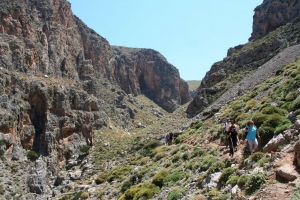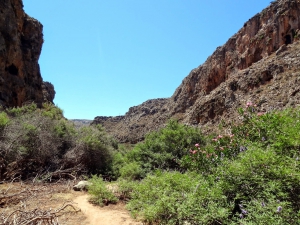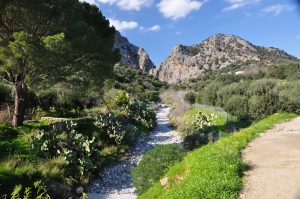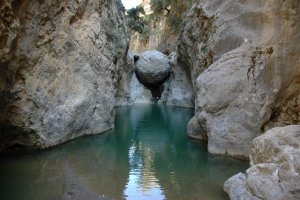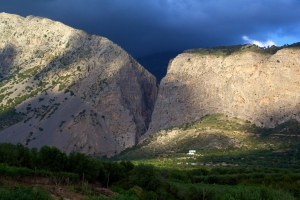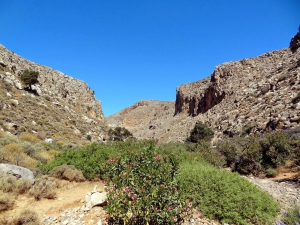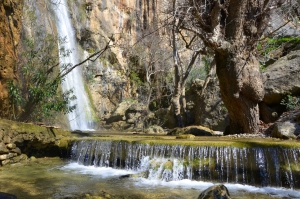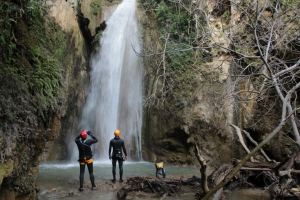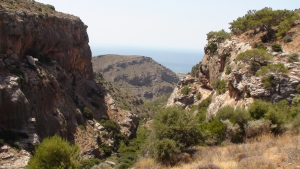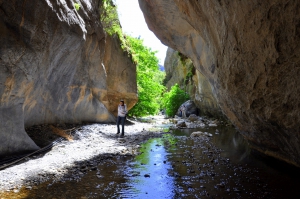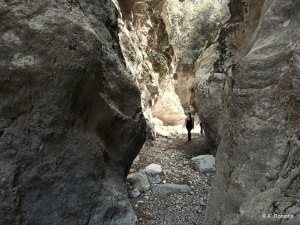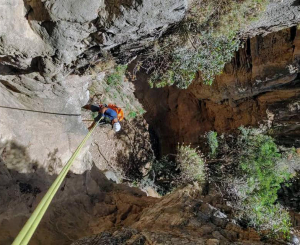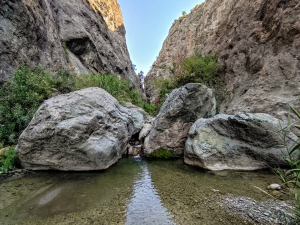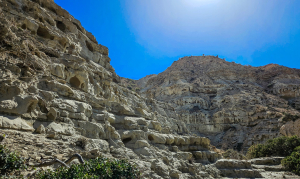The wild and imposing gorge of Kapsas is located 8-9km east of Makrigialos and 33km east of Ierapetra. The gorge is also called Pervolakia, because its northern entrance is near the secluded and picturesque village of Pervolakia. When in the village, you should walk in the nearby traditional village of Pezoulas, with the amazing houses.
The beautiful Gorge of Kato Zakros (or the gorge of the Dead) starts in a short distance from Ano Zakros, nearly 100km southeast of St. Nicholas, and ends at Kato Zakros. The beauty of the landscape, the historical importance of the gorge and its accessibility, attract many visitors every year.
Kritsa Gorge starts near the picturesque village of Kritsa, 9.5km southwest of Agios Nikolaos, and ends at the village Tapes. It’s 4km long, reaching a width of only 1.5m in some places. It is easily accessible with a few points that need attention, where you have to climb over some big rocks (not too hard). The only time you should not visit the gorge is when it has rained previously and there are ponds in the gorge, which block the passages.
Through the gorge passes Havgas river that carries water from the plateau of Katharo to Lassithi. Then the water reaches Chonos (the hole from which waters of the Lassithi Plateau escape the plateau), comes out from Fleves and reaches Aposelemis dam. The river has water for several months a year. Thus, make sure you get properly informed about the weather because the canyon carries a lot of water during periods of rainfall.
One dominant feature of the area of Ierapetra, in front of the beautiful village and the minoan settlement of Vassiliki is the Gorge Ha. It is considered one of the wildest gorges in Crete, a rare morphological phenomenon of nature, probably caused by tectonic earthquake.
The Gorge of Chochlakies or Karoumes is located in one of the most isolated areas of the island, near Kato Zakros. Easy hiking in the snakelike canyon with the sparse vegetation and the bare rocks, ends in the amazing beach of Karoumes, where being totally alone is the rule.
The Gorge of Mylonas or Agios Ioannis is located 18km east of Ierapetra. It starts near the village Agios Ioannis, at an altitude of 500m, and ends at the beach of Kakia Skala.
Nearby the lush green and full of water springs Orino village we meet one of the most steep rivers of Crete. Its springs are located high on the plateau Abelia on the slopes of Thripti and Papouri mounts. They shortly form a river which crosses the village square and enters the rugged canyon of Orino.
The Gorge of Pefki (Pefki means Pines) is one of the most beautiful small gorges of Crete, with amazing rock formations shaped by the natural forces and with lush vegetation. The length of the gorge is 4.5 km and the elevation difference of the entering point and the exit reaches 300 meters.The gorge starts south of the village Pefki and ends in Aspros Potamos dorp, 2km north of Makrigialos.
16km west of the Ierapetra is the traditional village of Mythi. At a short distance from the village, the small Sarakina Gorge starts, which ends near the Mirtos. The length of the canyon reaches 1.5km and its width ranges from 3 to 10 meters, with only a few points exceeding that.
Βoufanis gorge is formed southeast of Selakano and finishes between the villages Chirstos and Metaxohori of Viannos Province. Hiking is usually done by the old path that connects Selakano with Metaxochori and it passes high and parallel to its bed.
Agios Antonios is a technical gorge, ie its crossing requires technical means of canyoning, as it has ten waterfalls. The most imposing point in the gorge is the highest waterfall of 60 meters, which is completely smooth.
Lower Gorge (Kato Farangi) is located in the region of the village Mythi in the province Ierapetra. It is the last rocky part of the stream that runs through the river Myrtos or Kriopotamos.
Potamos beach in northwestern Gavdos is formed at the outlet of various small streams. Their soils are mainly clay, which makes them create special formations as they are dissolved by rain and wind. Some of the formed streams pass through harder rocks, creating deep canyons with waterfalls of amazing beauty, which, however, can be seen by someone with water even in winter relatively rarely.










